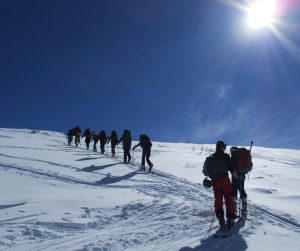How does water shape us
Perched as they are at the confluence of the Crystal and Roaring Fork Rivers, it is fitting that the ninth grade class at the Colorado Rocky Mountain School have found themselves immersed in the very lifeline of the West: water.
Through an inter-curricular water study unit, students have explored its braids, oxbows and side streams through English, history, world geography, science and the arts. The essential question being asked, says Academic Dean Nancy Draina, is “How do we shape water and how does it shape us?”
Students began their aqueous explorations with a tour of the Rockford Ditch. Rockford, one of the oldest ditches in Carbondale, pulls water from the Crystal River via the headgate near the fish hatchery, providing irrigation water to CRMS and Satank.
CRMS junior Jaime Lynn Butler spoke to her peers about her participation in the Children’s Land Trust Lawsuit. Currently, she is one of twenty-one youth plaintiffs suing the federal government over failure to take action on climate change. Butler has been an activist since the precocious age of nine when she wrote her first letter to President Obama.
Butler grew up on the Navajo reservation in Cameron, Arizona. It is true desert; neither land nor home has running water. They haul water in 50-gallon drums for personal and livestock water. She literally could not keep her horse in enough water, and had to sell him; she was heartbroken. Her grandfather tells her stories of the days when the Navajo could travel from spring to spring. The springs are drying up. She is striving to address this. She is a voice for the voiceless: those too young to vote. Butler acts on behalf of those who will outlive and be most affected by current lawmakers.
CRMS ninth graders are confronting these water crises: What’s so big about the Colorado River drying up before ever reaching the sea? Who advocates for the fish? Do river organisms even have water rights? “Prior appropriation”? Should we change Colorado River law? What are current proposals and who’s working on them? And, of course, there’s that proposed gondola into the Grand Canyon…
Students have waded into river ecology, examining what a healthy alpine stream looks like from a scientific perspective. What might an angler’s perspective be? Global warming and trout- where will that land? Does a Gold Medal Water designation help preserve rivers? How does macro invertebrate ecology influence the art of fly-fishing?
“River biology was pretty interesting,” student Ryder Pietsch says. “We went to the Crystal River and took samples. It was really cool to see how many different species of bugs live in the water and what they could tell us about the water quality. The Crystal is super clean; macroinvertebrates are pollution intolerant, so they wouldn’t be living if it was a little polluted.”
Students also studied the dynamic between humans and rivers. Delving into case studies of recent flood events, students asked, how should communities be built to protect river quality? To protect the built environment? What have the Front Range floods taught us?
Students contemplated the hard questions: Is it even ethical for water to be diverted to more arid places? What might the western water crisis say about the future of agriculture? What about trans mountain diversions- should the Western Slope allow water to be diverted to the Front Range, an entirely different watershed?
“We were looking at the relationship between abundance and scarcity, and here in the West, how dams play into scarcity and perceived abundance,” explains world geography teacher, Tracy Wilson. “We looked at it from the ethical standpoint of water…comparing vast impacts for such small gains.”
What tolls have they taken on environments and fisheries? What would happen if, for example, the Glen Canyon dam were to be dismantled? As students learned about private/corporate ownership of water, and land leases associated with dams, “the gears really started spinning,” Wilson chuckles.
Serena Johnson enjoyed the ethical debates in Wilson’s class. “Our group decided against building a hypothetically proposed dam.” Johnson pauses, pensive. “Someone could technically come around and dam the Roaring Fork River and flood acres of land, where we live. I think about how that happens to some people: they’ll have a perfectly normal life, and Boom! There’s a dam and their house is underwater.”
In the arts, ninth graders considered how literature and film shape opinion on water resources and its use. They explored narrative through 2-D works and ceramics.
Drama students read a short story by former CRMS student Paolo Bacigalupi ‘90. “The Tamarisk Hunter,” first published in High Country News, is an apocalyptic portrayal of water appropriation and its devastatingly remorseless effect upon lives in the West.
Student Alice Amdur was most inspired by her world literature class, in which she read Barbara Kingsolver’s “Animal Dreams.”
“It was about a town and how their river was being polluted,” explains Amdur, “and how important that river was, a part of their culture. The community came together to protect the river. They proved a small group of people can make a big difference.”
Amdur is from the city. “There were no rivers, just concrete,” she describes. For three years now, she has lived by the river. “I get to see it. I hear it at night. It’s become a part of my life.”
The culmination of their water study unit was the 2017 Youth Water Summit. On October 31, CRMS joined 7-12 graders from throughout our watershed to present projects and findings on their designated irrigation ditches, streams, and rivers. They also got to hear stories and watch films from local river water advocates and professionals. Based on the giggles, laughter, and applause, the summit was a hit.
In thinking critically, creatively, to tackle modern water issues, these incoming students have applied goals intrinsic to the CRMS mission. Freshmen assessed current waterway health and conditions; used science and historical data to analyze results; and synthesized information to communicate their findings effectively.
With their newly diversified awareness, CRMS students may propel water issues forward in the ways that are meaningful to them.
 MYCRMS
MYCRMS





 Virtual Tour
Virtual Tour

